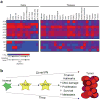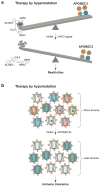The APOBEC3 family of retroelement restriction factors
- PMID: 23686230
- PMCID: PMC3934647
- DOI: 10.1007/978-3-642-37765-5_1
The APOBEC3 family of retroelement restriction factors
Abstract
The ability to regulate and even target mutagenesis is an extremely valuable cellular asset. Enzyme-catalyzed DNA cytosine deamination is a molecular strategy employed by vertebrates to promote antibody diversity and defend against foreign nucleic acids. Ten years ago, a family of cellular enzymes was first described with several proving capable of deaminating DNA and inhibiting HIV-1 replication. Ensuing studies on the apolipoprotein B mRNA-editing enzyme catalytic polypeptide-like 3 (APOBEC3) restriction factors have uncovered a broad-spectrum innate defense network that suppresses the replication of numerous endogenous and exogenous DNA-based parasites. Although many viruses possess equally elaborate counter-defense mechanisms, the APOBEC3 enzymes offer a tantalizing possibility of leveraging innate immunity to fend off viral infection. Here, we focus on mechanisms of retroelement restriction by the APOBEC3 family of restriction enzymes, and we consider the therapeutic benefits, as well as the possible pathological consequences, of arming cells with active DNA deaminases.
Figures




References
-
- Abudu A, Takaori-Kondo A, Izumi T, et al. Murine retrovirus escapes from murine APOBEC3 via two distinct novel mechanisms. Current biology : CB. 2006;16:1565–1570. - PubMed
-
- Aguiar RS, Lovsin N, Tanuri A, Peterlin BM. Vpr.A3A chimera inhibits HIV replication. J Biol Chem. 2008;283:2518–2525. - PubMed
Publication types
MeSH terms
Substances
Grants and funding
LinkOut - more resources
Full Text Sources
Other Literature Sources

